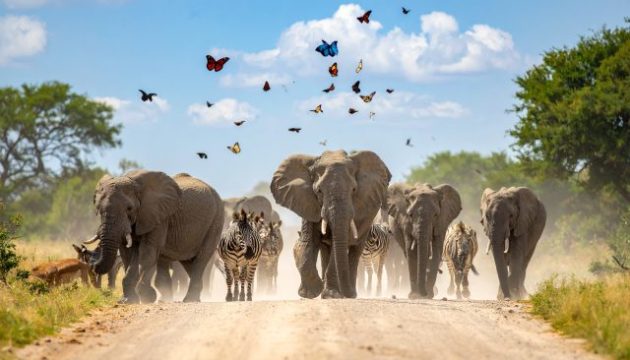What drives a tiny butterfly to fly 3,000 miles or a vast herd to chase the rains across an entire continent? The answer is animal migration, one of nature’s most awe-inspiring spectacles and a powerful survival strategy.
These aren’t just simple trips; they are epic quests guided by ancient instincts against impossible odds, pushing the absolute limits of endurance. Crossing oceans, deserts, and mountains, these annual journeys are essential for animals to reach food sources, find safe breeding grounds, or escape the harshest climates. The sheer scale and precision of these movements are a testament to the resilience of the animal kingdom.
These ancient routes, followed for millennia, reveal incredible feats of navigation and instinct. However, many are now under threat from climate change and habitat destruction, making their stories more important than ever to understand and protect.
In this list, we’ll journey across the globe to witness 10 of the most incredible animal migrations. From the depths of the ocean to the highest skies, you will discover the science, the scale, and the sheer determination behind these great migrations. Prepare to be amazed by the world’s greatest travelers.
10. Wildebeest – The Great Migration
Every year, over 1.5 million wildebeest, joined by zebras and gazelles, set out on what is often called the greatest wildlife migration on Earth. This circular journey spans 1,200 miles across the Serengeti in Tanzania and the Masai Mara in Kenya. Wildebeest are driven by the search for fresh grass and water, following seasonal rains that transform the savannah.
The migration is not just a breathtaking spectacle but a survival drama. Along the way, wildebeest face predators such as lions, cheetahs, and hyenas. One of the most dramatic moments occurs when the herds cross the Mara River, plunging into waters teeming with crocodiles. Thousands can perish in a single crossing, yet the migration continues year after year, a cycle of life and death.
The Great Migration also supports one of the most complex ecosystems on Earth, making it a must-see for wildlife enthusiasts and a vital process for Africa’s grasslands.
9. Zebra Migration in Botswana
The zebra migration in Botswana is the longest land migration of any mammal in Africa, stretching about 300 miles round-trip across the Kalahari Desert. Each year, thousands of zebras travel between the Okavango Delta and the Makgadikgadi Pans in search of grazing land and water.
This migration is particularly challenging because it passes through one of the driest regions in southern Africa. Zebras must endure extreme heat, scarce water, and predators like lions and wild dogs. Yet the instinct to move is vital for survival, ensuring access to resources that can sustain the herds.
Scientists only recently rediscovered the full extent of this migration using GPS tracking. Today, conservationists are working to keep the zebras’ route open, as fences and development threaten to block their path. This little-known journey is a reminder that even iconic animals like zebras face migration challenges in a changing world.
8. Red Crabs of Christmas Island
Every year on Christmas Island in the Indian Ocean, millions of bright red crabs march from the forest to the sea in one of the most unusual migrations on Earth. This synchronized event, triggered by the first rains of the wet season, sees crabs swarming across roads, cliffs, and beaches to reach the ocean to spawn.
The spectacle is so massive that local roads are closed to protect the crabs. Special bridges and tunnels have even been built to help them cross safely. For weeks, the island is transformed into a moving sea of scarlet.
This migration is a critical part of the island’s ecosystem. The crabs play a vital role in nutrient cycling and forest regeneration. Protecting their migration has become a model of how humans can coexist with wildlife, ensuring one of the world’s most unusual natural spectacles continues.
7. Elephants in Mali
In the deserts of Mali, a small population of elephants undertakes the longest-known migration of any elephant group. Each year, they follow a 300-mile circular route in search of water and food. This journey, which winds through harsh desert terrain, is essential for survival in one of the driest regions on Earth.
Unlike savannah elephants that can rely on more abundant resources, Mali’s elephants must remember and share knowledge of seasonal waterholes that may dry up for months at a time. Their migration is a living map passed down through generations, guided by memory and social bonds.
This elephant population is under serious threat from habitat loss, poaching, and climate change. Conservation groups are working with local communities to protect their routes, ensuring that this extraordinary migration continues in one of the toughest environments on the planet.
6. Salmon
The life cycle of salmon is one of the most dramatic stories in the animal kingdom. Born in freshwater rivers, young salmon migrate to the ocean, where they spend several years growing to adulthood. When it’s time to spawn, they undertake an incredible journey back to the exact river where they were born, traveling hundreds or even thousands of miles.
This return migration is grueling. Salmon must swim upstream against powerful currents, leaping up waterfalls and rapids. Many are picked off by bears, eagles, and other predators along the way. Driven by instinct, they push on even as their bodies begin to decay, earning them the nickname “zombie salmon.” This powerful drive ensures they reach their spawning grounds, though they often perish soon after.
Salmon migrations are critical to entire ecosystems. Their bodies, rich in nutrients, feed forests and wildlife after they die. Human activity, however, threatens salmon migrations, with dams, overfishing, and warming waters putting enormous pressure on populations worldwide.
5. Humpback Whales
Humpback whales are among the largest animals on Earth, and their migration is one of the most awe-inspiring in the ocean. These giants travel up to 8,000 miles round-trip, moving between cold feeding grounds in polar seas and warm tropical waters where they mate and give birth.
During their migrations, humpbacks rely on rich feeding areas filled with krill and small fish to build up the fat reserves they’ll need for the long journey and months without food in breeding areas. Along the way, they’re known for breaching – leaping spectacularly out of the water, and for singing complex songs that can travel vast distances underwater.
Conservation efforts have helped humpback populations recover from the brink of extinction after commercial whaling, but they still face threats such as ship strikes, noise pollution, and entanglement in fishing gear. Their epic migration remains one of the ocean’s greatest spectacles.
4. Caribou (Reindeer)
Caribou, also known as reindeer in some regions, are famous for their long migrations across the Arctic tundra. Certain herds can travel more than 3,000 miles in a single year, moving continuously between calving grounds and winter feeding areas. Unlike many migratory animals that travel in one long stretch, caribou are almost always on the move.
These journeys are essential for survival, as food in the Arctic is scarce and seasonal. Caribou must follow the cycles of lichen, grasses, and shrubs that they depend on. Along the way, they face challenges such as wolves, deep snow, and freezing rivers.
Caribou migrations are also deeply tied to Indigenous cultures of the Arctic, who rely on these animals for food, clothing, and tradition. But climate change and industrial development are disrupting migration routes, raising concerns for both caribou populations and the people who depend on them.
3. Monarch Butterflies
The migration of monarch butterflies is one of the most remarkable journeys in the insect world. Every fall, millions of monarchs, each weighing less than a paperclip, travel up to 3,000 miles from Canada and the northern United States to spend the winter in the mountains of central Mexico. Even though they are so tiny, these butterflies can cover 50 to 100 miles a day, gliding on air currents to conserve energy. Despite their fragile wings, monarchs endure storms, predators, and exhaustion on their way south, guided by an internal compass and environmental cues.
What makes their migration extraordinary is that no single butterfly completes the round trip. The journey is multi-generational. Monarchs that leave North America in the fall will never return. Instead, their descendants continue the route in spring, making their way back north.
Sadly, monarch butterfly populations are under threat due to habitat loss, pesticides, and climate change. The loss of milkweed, the only plant where monarchs lay their eggs, is especially damaging. Conservation efforts across North America aim to protect this delicate species and preserve its awe-inspiring migration for future generations.
2. Leatherback Sea Turtles
Leatherback sea turtles are ancient mariners that have roamed Earth’s oceans for over 100 million years. They undertake some of the longest migrations of any reptile, with individuals traveling up to 10,000 miles a year. Females return to the very beaches where they hatched to lay their eggs, navigating with remarkable precision.
Their journeys span entire oceans. For example, some leatherbacks migrate from nesting sites in the Caribbean all the way to feeding grounds off Canada’s east coast. They are able to dive deeper than any other turtle, reaching depths of over 3,000 feet in search of jellyfish.
Sadly, leatherback turtles are critically endangered. Their migrations are threatened by fishing nets, plastic pollution, and climate change that alters nesting beaches. Conservation efforts are global, reflecting the turtles’ vast range and the importance of protecting one of the ocean’s oldest travelers.
1. Arctic Tern
The Arctic tern performs the longest known migration of any animal on Earth, covering up to 44,000 miles every year. This small seabird breeds in the Arctic during the summer, then flies all the way to Antarctica to enjoy the southern summer, essentially chasing sunlight year-round. By the time an Arctic tern has lived its average lifespan of 30 years, it may have flown the equivalent of several round trips to the moon.
Scientists are fascinated by how these birds navigate such immense distances. Using cues from the sun, stars, and Earth’s magnetic field, Arctic terns are master navigators. Their migration routes even allow them to take advantage of prevailing winds, making their journeys more efficient.
The Arctic tern’s migration is not only a feat of endurance but also a testament to the power of instinct. No other animal travels so far, making this bird a true champion of the natural world.



